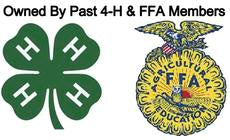Participants in the Northwest Project Grass Grazing Field Day got a break in the rainy weather with blue skies and moderate temperatures — not a typical July day.
Held on two neighboring farms, the field day provided hands-on experience with the use of grazing systems with a large dairy herd and a cow-calf operation.
John and Amy Vanderstappen, owners of Van de Jersey Dairy Farm, use grazing to augment the total mixed ration they feed their registered Jersey dairy herd.
The participants in the field day were taken on three wagons through the pasture system to see the access road, watering systems and fencing that are used with the cattle. Vanderstappen pointed out that he had put in drainage tiles in many of his pastures.
“Tiling is important in pastures as well as on cropland,” he said. “It will pay for itself in three years. If we hadn’t tiled, we wouldn’t have been able to use many of these fields with all the rain we have had.”
Vanderstappen said he believes his cattle are healthier by being on pasture for half of the day. From April to September, the cattle are on pasture at night, and then in September they are switched to being on pasture during the day.
In late November, he brings all the cattle into the barns for the winter. He also doesn’t want his cattle in the pastures during deer hunting season.
Some of the cattle walk about half a mile from the barn to get to the pasture, crossing two roads in the process. Vanderstappen said the public is quite patient when the cows are crossing the road. Because they are the younger cattle, they move rather quickly.
“We only put the younger cattle on the pastures that are far from the barn,” Vanderstappen said. “We keep the older cattle in the fields close to home.”
Using a Natural Resources ConField
Day Shows Grazing’s Benefits, Whether Dairy or Beef
Photos by Carol Ann Gregg
John Vanderstappen explains the watering system in his heifer pasture that is fed by a nearby spring.
Ryan Miller points out assets and challenges in his beef grazing system.servation Service cost-share program, Vanderstappen improved the main road that leads to all the paddocks for the milking herd.
Vanderstappen and his crew did the laneway improvement by laying fabric then 2.5-inch stone, then 1-inch stone and then fines.
“You want the top soft so it won’t hurt the cows’ feet,” he said.
Vanderstappen talked about the benefits of the pasture system for his dairy, which is currently milking about 270 cows.
“I don’t see much change in milk production from when they are on pasture and when they aren’t,” he said. “There is about half the manure to haul in the summer. The cows receive about a third of feed from the pasture.”
Because the farm is successful raising calves, it has a surplus of high-quality Jersey cattle to market for dairy purposes. In 2013, the farm sold about 100 head to other dairy operations.
Vanderstappen said the farm’s calf-raising system has been changed to provide the calves with three-quarters of a gallon of pasteurized milk twice a day for three months.
Jersey heifers wait to be moved to another pasture.
The farm has moved from hutches to small groups of calves, and Vanderstappen said he is happy with the results.
“It is expensive to raise calves, but they are much healthier and bigger on this system,” he said.
Van de Jersey Dairy Farm is now using a new freestall barn with a liquid manure system. It is also using a custom manure hauler that Vanderstappen said is saving the farm money.
The new barn has a loafing area for cows about to calve.
There are four full-time and four part-time employees who see to the day-to-day operation at Van de Jersey Dairy Farm.
The field day continued at the beef farm of Ryan Miller. He began raising cattle with his dad more than 20 years ago. About six years ago, he purchased the farm where he and his family now live. They have 20 brood cows.
Miller led the tour through part of his pastures. He was concerned with how rough the pasture was after this past winter. He also talked about his system and how he can provide shade through an adjoining paddock during the heat of summer.
Because the system is relatively new, Miller was searching for input from other producers and agency staff who were participating in the field day.
While in the pastures, Extension educator Joel Hunter gave a presentation on the characteristics of different grass species with recommendations for seeding to provide a diverse stand of grass for the grazing animals.
Recent Posts
-
Farm & Fencing Solutions for Poultry and Livestock
-
Solar Electric Fence Energizer Maintenance
-
Tools & Accessories Needed to Install Your New Energizer
-
Tips for proper installation of a livestock electric fence
-
How does an electric fence work?
-
Gallagher M1100 Fence Charger
-
New - Obriens Tredaline Step-in posts are here!
-
how to install solar fence chargers -gallagher
-
How Electric fence works - Keep it simple.
-
How to troubleshoot electric fence problems
Products Available
- Gallagher i Series Energizers
- Gallagher MBS Energizers
- Gallagher AC Energizers
- Gallagher Battery Energizers
- Gallagher Solar Energizers
- Electronic, Battery, Solar Items
- Lightning & Grounding Items
- Fence Testers, Voltmeters
- Gallagher Smart Fence System
- Turbo-wire, Poli-wire, Metal wire
- Turbo-tape & Poli-tape
- Gallagher Tumblewheels
- Fence Reels, Fence Posts
- Electric Fence Insulators
- Hardware, Strainers, Clamps
- Gate Hardware & Handles
- Gallagher Fencing Tools
- Whitetail Food Plot, Wildlife, Garden, Apiary Fence
- Poultry, Sheep & Goat Netting
- Gallagher Cattle Prods
- Gallagher Cattle Scales and Livestock Weighing Systems
- Gallagher Water, Fuel, Fertilizer Tank Monitoring System
- Livestock Watering Systems
- Goodnature Rat & Mouse Traps
- Portable Shade Structures for Cattle & Grazing Livestock
- Bulk Quantity Orders
- All Categories





